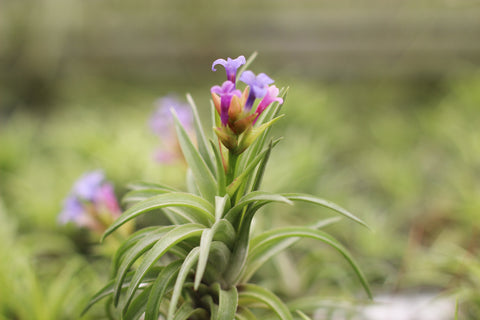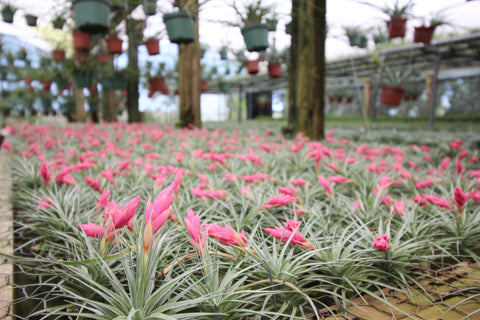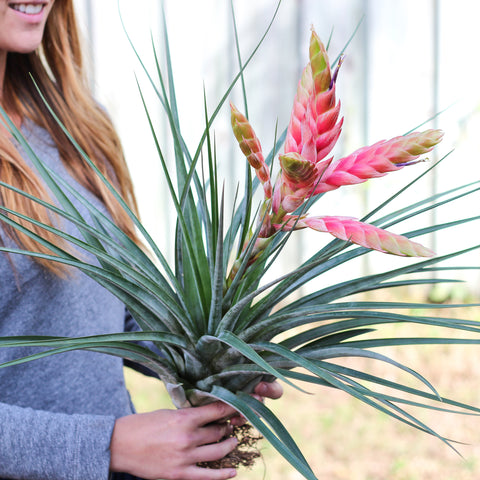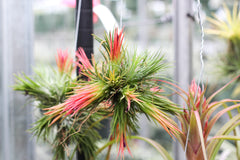How To Water An Air Plant In Bloom
The wait is over! After meticulous honey and intendance, your air plant has finally bloomed! How did information technology become to this point, you may ask, and how do I properly nurture my blooming air institute? Or maybe you're all the same waiting patiently for your Tillandsia to flower and wondering how you tin can help encourage the process. In either case, this post is for you.
 Allow'south beginning with a fiddling background info on the air plant blooming bike. As with whatever angiosperm, the bloom marks the kickoff of reproductive process in an air found's life cycle. You lot may be surprised to learn that air plants only flower once in their lifetime. Tillandsia produce unlike blooms depending on their species, many of them producing beautifully colored blossoms that come in a myriad of colors ranging from delicate pinks and fiery reds, to bright purples and yellows.
Allow'south beginning with a fiddling background info on the air plant blooming bike. As with whatever angiosperm, the bloom marks the kickoff of reproductive process in an air found's life cycle. You lot may be surprised to learn that air plants only flower once in their lifetime. Tillandsia produce unlike blooms depending on their species, many of them producing beautifully colored blossoms that come in a myriad of colors ranging from delicate pinks and fiery reds, to bright purples and yellows.
There are many different styles of blooms within the Tillandsia world. Some plants, such as the capitata peach blush a pale pink color when information technology starts to bloom and flowers are emitted straight from the center of the plant. Other plants such as the aeranthros and stricta have small buds that grow from the centre of the plant. Eventually, the bud grows larger and opens up to reveal flowers. Some blooms last a few days, while others can last up to a few weeks.

Some air plants have a much longer bloom bicycle and these longer cycles are common in larger plants such as the head-medusae and the xerographica. These plants grow large bloom tracts called inflorescence that tin can abound to over a human foot tall for some varieties! Over time, the flowers on the tract open up and release from the inflorescence. Some Tillandsias can have a bloom tract that concluding over a year.

After the bloom:
Once the bloom cycle has completed you may detect some new growth off the side of your air plant. These are babe air plants, commonly called offsets or "pups." These fiddling babies will somewhen mature into their own "adult" air plant and the cycle will begin over again! To encourage the next stage of growth after the bloom, yous can snip off the bloom tract that came out of the plant and this volition jump start the pup stage! On average, 1 to 3 pups will be created by the air plant after blooming, depending on the air establish species. After the pups abound to near i/three of the size of the mother plant, yous can remove them or leave them to form a clump.
over again! To encourage the next stage of growth after the bloom, yous can snip off the bloom tract that came out of the plant and this volition jump start the pup stage! On average, 1 to 3 pups will be created by the air plant after blooming, depending on the air establish species. After the pups abound to near i/three of the size of the mother plant, yous can remove them or leave them to form a clump.
Getting your air plants to bloom:
About healthy Tillandsia volition blossom eventually, but they require proper care and plenty of light in order to do then. To assist speed up the blooming process, you lot can use a diluted fertilizer like our particularly formulated Air Constitute Food once per month or so to encourage blooms and pup production.
Caring for blooming plants:
So is at that place whatever special care for a Tillandsia in bloom? First, and foremost, keep watering and feeding your institute! Notwithstanding, you'll want to take special care when watering blooming air plants not to become the blossom moisture, and then we recommend that instead of dunking or soaking the whole establish, y'all douse, mist, or hold under gently flowing h2o only the portions of the air plant that allow y'all to avoid wetting the bloom. If the bloom is submerged in water for also long, it could rot or wilt. A blooming plant may need a lilliputian more water than usual since all of its energy is going into the bloom and eventually the pups. Make sure to keep an heart on your plant so that information technology stays happy and healthy!
With calorie-free, water, and a fiddling fertilizer, you may go to enjoy blooms of your ain! Happy blooming!
Exercise you want to know what happens next? Check out the next post in the blooming serial, Afterwards the Bloom and our postal service all about Air Plant Propagation.
Back to Air Plant Encyclopedia
How To Water An Air Plant In Bloom,
Source: https://www.air-plants.com/blogs/air-plant-encyclopedia/all-about-those-blooms-the-air-plant-blooming-process
Posted by: mcdowelllicand.blogspot.com


0 Response to "How To Water An Air Plant In Bloom"
Post a Comment